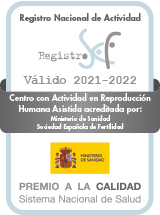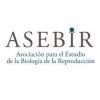Have you ever wondered what happens to the semen samples, eggs or embryos resulting from assisted reproduction treatment? We tell you what vitrification technique consists of and for what purposes it is used in assisted reproduction.
What is vitrification and what is it indicated for?
Vitrification is a technique that consists of freezing tissue or cells to preserve them for future use. This technique is used in assisted reproduction to freeze and store semen samples, eggs and viable embryos that have after the initial fresh embryo transfer, i.e. after in vitro fertilization.
It is a technique indicated to preserve these samples for future use, either by the same woman or the same couple or for donation. To give you a better idea, the resulting embryos after performing an IVF cycle can be saved for a new attempt at parenthood in the future, can be donated to other women or other couples, or can be donated for research. The vitrification technique is used to guarantee the adequate preservation of these embryos.
Vitrification is an ultra-rapid freezing technique that replaced the slow freezing technique used before the introduction of this new technique. Survival rates have increased since the introduction of vitrification and higher pregnancy rates have been achieved in frozen embryo transfers.
Egg vitrification is a relatively new technique that has revolutionized fertility preservation. Previously, a slow freezing technique was used, which often damaged the eggs due to the formation of ice crystals. Vitrification, on the other hand, uses an ultra-rapid freezing technique that converts the liquid in the eggs into a solid state in a matter of seconds, thus avoiding the formation of ice crystals.
The egg vitrification process begins with a cycle of ovarian stimulation to produce several mature eggs. Once the eggs reach maturity, they are extracted by ovarian puncture and processed in the laboratory for vitrification.
The eggs are immersed in a cryoprotective solution that protects them during the vitrification process. They are then placed in small plastic straws and immersed in liquid nitrogen at a temperature of -196°C. The vitrified eggs are stored in a liquid nitrogen tank until the woman is ready to use them.
The cost of egg vitrification varies by country and clinic. In general, it is a costly treatment that can range from 2,000 to 5,000 euros. Often, there are also additional costs associated with the medication that must be used in ovarian stimulation and maintenance of the preserved oocytes.
Egg vitrification is a safe and effective technique that can help women preserve their fertility. The technique has been successfully used worldwide, and vitrified eggs can be stored for several years without losing their quality. Egg vitrification may also be an option for women who wish to delay childbearing for personal or professional reasons, and for patients who need to undergo medical treatments that may affect their fertility, such as chemotherapy.
In summary, egg vitrification is a fertility preservation technique that can help women have children in the future. Although expensive, egg vitrification is an important investment in long-term health and family planning.
Our Fertility Treatments
RO-Ovarian rejuvenation
It is a revolutionary technique that consists in the reactivation of stem cells and follicles remaining in the ovary.
AI – Artificial Insemination
It is an assisted reproduction technique that will help you get pregnant in a simple and safe way.
IVF – In Vitro Fertilization
It is the union of the egg with the sperm in the laboratory, in order to obtain already fertilized embryos to be transferred to the mother’s uterus and achieve pregnancy.
Ovodonation
Fertility treatment consisting of In Vitro Fertilization with anonymous donor eggs. If necessary, this egg is fertilized with sperm from the couple or from another donor.
Genetic diagnosis
It refers specifically to the technique used in the event that one or both parents have a genetic anomaly. The embryo is analyzed to determine if it carries the same genetic abnormality.
ROPA Method
In Vitro Fertilization treatment shared between both women. One woman is the egg donor, while the other woman is the embryo donor.
Request your FREE QUOTE
Official Certificates:
National Registry of the Spanish Fertility Society








